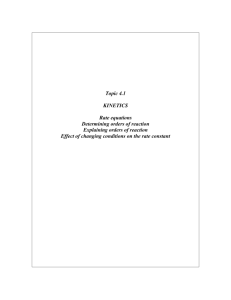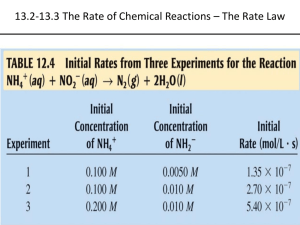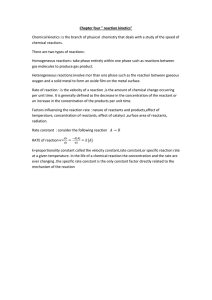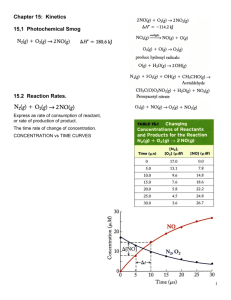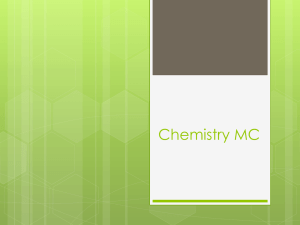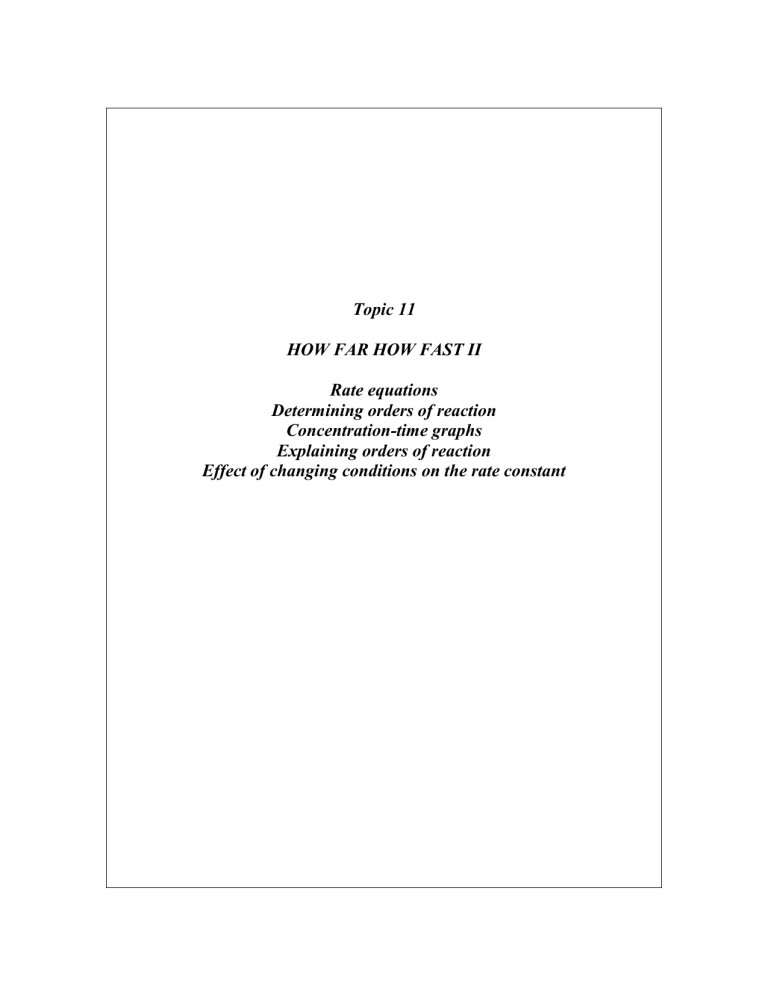
Topic 11 HOW FAR HOW FAST II Rate equations Determining orders of reaction Concentration-time graphs Explaining orders of reaction Effect of changing conditions on the rate constant RATE EQUATIONS The relationship between the rate of a chemical reaction and the concentration of the reactants is shown by the rate equation of the reaction. Consider the reaction A + 3B 2C + 4D The rate of this chemical reaction is given by the equation Rate = k[A]x[B]y [A] is the concentration of A, and [B] is the concentration of B. x and y are the orders of reaction with respect to A and B respectively. The order of reaction with respect to a given reactant is the power of that reactant's concentration in the rate equation. The sum of these powers, in this case x + y, is known as the overall order of reaction: The overall order of reaction is the sum of the powers of the reactant concentrations in the rate equation k is the rate constant of the reaction. The rate constant is the constant of proportionality in the rate equation. During a chemical reaction, the concentration of the reactants decreases and the concentration of the products increases. variation of concentrations of reactants and products with time products concentration reactants time The rate of a reaction is the decrease in concentration of reactants per unit time, or the increase in concentration of products per unit time. The units of rate of reaction are moldm-3s-1. DETERMINING ORDERS OF REACTION The orders of reaction with respect to each reactant in the reaction can be determined by carrying out the reaction with various different initial concentrations and measuring the change in initial rate of reaction. The orders of reaction can be determined arithmetically or graphically. If the order of reaction with respect to one reactant is being determined, the concentration of one reactant only should change; the others should remain constant so that the change in rate can be attributed to the change in concentration of that reactant alone. If the overall order is being determined, the concentration of all reactants should change by the same factor. 1. The arithmetic method (change in concentration)order of reaction = change in rate If the reaction is first order, then if the concentration doubles the rate will also double. If the concentration triples the rate will also triple, etc. If the reaction is second order, then if the concentration doubles the rate will quadruple. If the concentration triples the rate will increase ninefold, etc. If the reaction is zero order, then the change in concentration will have no effect on the rate of reaction. Example 1 Consider the reaction RX + OH- ROH + XThe following rate data were obtained at constant temperature: Initial concentration of RX/ moldm-3 0.01 0.01 0.005 Initial concentration of OH/ moldm-3 0.04 0.02 0.04 Initial rate/ moldm-3 s-1 8 x 10-3 4 x 10-3 4 x 10-3 From expt 2 to expt 1, the concentration of hydroxide ions doubles and the concentration of RX is unchanged. The rate also doubles, so the order of reaction with respect to OH- is 1. From expt 3 to expt 1, the concentration of RX doubles and the concentration of hydroxide ions is unchanged. The rate also doubles, so the order of reaction with respect to RX is also 1. The rate equation can thus be written as follows: rate = k[RX][OH-] Having deduced the rate equation, the rate constant can be calculated using the data in one of the experiments. Eg in expt 1, k = rate/([RX][OH-]) = 8 x 10-3/(0.04 x 0.01) = 20 mol-1dm3s-1. Example 2 Consider the reaction PCl3 + Cl2 PCl5 The following rate data were obtained at constant temperature: Initial concentration of PCl3/ moldm-3 0.2 0.4 0.8 Initial concentration of Cl2/ moldm-3 0.1 0.1 0.2 Initial rate/ moldm-3 s-1 0.0004 0.0008 0.0064 From expt 1 to expt 2, the concentration of PCl3 doubles and the concentration of Cl2 is unchanged. The rate also doubles, so the order of reaction with respect to PCl3 is 1. From experiment 2 to experiment 3, the concentration of both reactants doubles. The rate increases eightfold, so the overall order of reaction is three. The order of reaction with respect to chlorine is therefore 3 – 1 = 2. The rate equation can thus be written as follows: rate = k[PCl][Cl]2 So k = rate/[PCl3][Cl2]2 = 0.0004/(0.2 x 0.12) = 0.2 mol-2dm6s-1 2. The Graphical method If the concentrations in the different experiments are not simple whole number ratios of each other, it is not easy to compare the concentrations and rates. The order of reaction with respect to each reactant can be deduced by plotting a graph of concentration vs initial rate (an initial rate-concentration graph) a) first-order reactions If Rate = k[A], then a plot of initial rate against initial concentration will be a staight line through the origin of gradient k: b) second-order reactions If rate = k[A] 2, then a plot of initial rate against initial concentration will be a curve through the origin. c) zero order reactions If rate = k, then a plot of initial rate against initial concentration will be a horizontal line: An even better method is to plot log (rate of reaction) against log (concentration). This should always give a straight line, the gradient of which is the order of reaction. 3. Measuring initial rates of reaction In some reactions, it is not easy to measure the rate of reaction directly, and easier to mention the time taken for a particular stage in the reaction to be reached. Since rate is the change in concentration per unit time, it follows that the rate is inversely proportional to time taken. A graph of 1/t against initial concentration will give curves like those shown above. Examples of such measurements could be: - time taken for fixed amount of gas to be produced - time taken for absorbance to change by a certain amount - use of a clock reaction: the appearance of a certain coloured product is delayed by adding a fixed amount of another species. Eg S2O82-(aq) + 2I-(aq) 2SO42-(aq) + I2(aq) Iodine is produced in this reaction. If starch was added to the original mixture, a blueblack colour would appear immediately. However if a fixed amount (ie 0.02 moles) of sodium thiosulphate is also added to the mixture, it reacts with the iodine and a blue-black colour is only seen when all the thiosulphate has been used up. It is possible to measure the time taken for the blue-black colour to appear. CONCENTRATION-TIME GRAPHS It is not always possible to carry out several different experiments. It is possible to obtain much useful information about the kinetics of a reaction by monitoring how the concentration of a reaction changes over time in a single reaction, and then plotting a graph of concentration against time (a concentration-time graph). A typical concentration-time graph would look like this: Eg for the reaction SO2Cl2 SO2 + Cl2 a) finding the rate of reaction from the graph The rate of reaction is the change in concentration per unit time and can therefore be calculated from the gradient of the line at a particular time. As the graph is a curve (its gradient is steadily decreasing with time), the gradient of the line at a particular point must be calculated by drawing a tangent to that line at a particular point and calculating the gradient of that tangent. www.avogadro.co.uk The initial rate of reaction is the gradient of the tangent to the curve at t = 0. The rate of reaction at a particular time is the gradient of the tangent to the curve at that particular time. b) Deducing the order of reaction and the rate constant from the graph By measuring the gradients of the tangents at different points on the curve, it is possible to deduce the order of reaction by the arithmetic method: Taking the concentration-time graph for the decomposition of SO2Cl2 (above): Start by measuring the initial rate of reaction: The initial concentration of SO2Cl2 is 0.5 moldm-3. The gradient of the tangent to the curve at this point is 1.6 x 10-4 moldm-3s-1 Then measure the rate of reaction after the concentration of SO2Cl2 has fallen to half of its initial value: After 2200 s, the concentration of SO2Cl2 is 0.25 moldm-3. The gradient of the tangent to the curve at this point is 8.0 x 10-5 moldm-3s-1 It is clear that when the concentration of SO2Cl2 halves, the rate of reaction also halves. This shows that the order of reaction with respect to of SO2Cl2 is 1 and that the rate equation is therefore rate = k[SO2Cl2]. If the rate of reaction has fallen by a factor of 4 when the concentration had halved, it would show that the reaction was second order. If the rate of reaction had not fallen at all when the concentration had halved, it would show that the reaction was zero order. The rate constant can be determined by rearranging the rate equation: k = rate/[SO2Cl2] EXPLAINING ORDERS OF REACTION The orders of reaction for a chemical equation are not always the same as the reaction coefficients: Eg the reaction NO2 + H2 NO + H2O has the following rate equation: rate = k[NO2]2 It is therefore not possible to predict the rate equation of a reaction simply by looking at the reaction coefficients. Many reactions consist of a series of different steps, some of which are slow and some of which are very fast. It is the slowest step in a chemical reaction which determines how fast a reaction is. For this reason the slowest step in a chemical reaction is called the rate-determining step. Changing the rate of this step will affect the overall rate of reaction; changing the rate of fast steps won’t. Eg consider the reaction NO2 + H2 NO + H2O This reaction happens in two steps: Step 1: NO2 + NO2 NO3 + NO this step is slow Step 2: NO3 + H2 NO2 + H2O this step is fast Step 1 is the slowest step and is therefore the rate-determining step. This involves two molecules of NO2, and so doubling the concentration of NO2 will make collisions in this step four times more likely. So the reaction is second order with respect to NO2. H2 is not involved in this step; it is only involved in the second, fast step. Changing the concentration of H2 therefore has no effect on the rate of reaction, and the reaction is zero order with respect to H2. The rate equation of a chemical reaction is determined by the number of each species involved in the rate-determining step of that reaction. EFFECT OF CHANGING CONDITIONS ON THE RATE CONSTANT 1. Effect of concentration, pressure and temperature on the rate constant The rate equation shows the relationship between the concentration of reactants and the rate of reaction. If the concentration of one of the reactants increases, the rate of reaction will also increase, the rate constant, k will not change. If the pressure increases, the concentration of all the reactants will increase and so the rate of reaction will also increases. Again the rate constant will not change. The rate constant k is thus independent of concentration and pressure. If the temperature increases, however, or a catalyst is added, the rate of reaction increases without a change in concentration, and so it must be the rate constant, k, that is changing. The rate constant k thus varies with temperature, and is also affected by the addition of a catalyst. If the temperature is increased, the rate constant k will increase. If the temperature is decreased, the rate constant k will decrease. If the concentration or pressure is changed at constant temperature, the rate constant will not change. 2. The Arrhenius Equation The relationship between the rate constant of a reaction and the temperature can be quantified using the Arrhenius equation: k = Ae(-Ea/(RT)) In this equation, Ea is the activation energy for the reaction (in Jmol-1), T is the temperature (in K), R is the molar gas constant (in Jmol-1K-1) and A is the Arrhenius constant (which varies from reaction to reaction) Taking the logarithm of both sides of this equation gives you: logk = logA – Ea/(RT) A graph of logk against 1/T should therefore give a straight line of gradient Ea/R. This gradient can be used to determine the activation energy of the reaction. The activation energy of a reaction can therefore be determined experimentally by comparing the rate of reaction at different temperatures, by plotting a graph of log (rate of reaction) against 1/T and finding the gradient of the line. For example, the initial rate of reaction between HCl and Na2S2O3 can be monitored at different temperatures by measuring how long it takes for the Sulphur produced during this reaction to prevent an X on a piece of paper under the reaction flask from being visible. A value proportional to k can be found by calculating (1/time taken) T (K) Time taken for X to cease to be visible (s) (1/time taken)/s-1 298 105 9.5 x 10-3 308 52 1.9 x 10-2 318 25 4.0 x 10-2 328 13 7.7 x 10-2 Then logk and 1/T can be calculated: T (K) 1/T (K-1) (1/time taken)/s-1 Log (1/time taken) 298 3.36 x 10-3 9.5 x 10-3 -2.02 308 3.25 x 10-3 1.9 x 10-2 -1.72 318 3.14 x 10-3 4.0 x 10-2 -1.40 328 3.05 x 10-3 7.7 x 10-2 -1.11 A graph of log(1/time taken) against 1/T can then be plotted: The gradient of this line can then be taken and it is approximately -2900K According to the Arrhenius equation, this gradient = -Ea/R So Ea = -2900 x R = 24000Jmol-1 = 24kJmol-1 EQUILIBRIUM CONSTANTS AT CONSTANT PRESSURE, Kp Equilibrium constants, Kc, were introduced in Topic 5 of AS Chemistry: Consider the reversible reaction A + 3B C + 2D The equilibrium constant for the reaction can be given as: Kc = [C][D]2 [A][B]3 Kc expressions can be used to calculate the expected amounts of each reactant and product expected at equilibrium. They can be used when the reactants are in aqueous solution or mixed together as liquids. They can also be used in gaseous reactions provided that the volume of the container is fixed. However many reversible reactions take place in the gas phase in open systems of no fixed volume – these reactions take place at constant pressure, rather than at constant volume, and in such cases Kc cannot be used. Equilibrium constants for such reactions can be set up by considering the partial pressure (p) of the reactants and products in the mixture. The partial pressure of a component in a gaseous mixture is given by: Partial pressure of component = mole fraction of component x total pressure Where mole fraction is given by: Mole fraction = moles of that component total number of moles Eg Consider the the equilibrium 2N2O5(g) == 2N2O4(g) + O2(g) The expression for the equilibrium constant at constant pressure (Kp) can be set up as follows: Kp = (p(NO2))2p(O2) (p(N2O5))2 p(N2O5) is the partial pressure of N2O5 in the mixture p(NO2) is the partial pressure of NO2 in the mixture p(O2) is the partial pressure of O2 in the mixture In an experiment at a constant pressure of 100 kPa, the moles of N2O5, N2O4 and O2 are found to be 1.0, 0.11, and 0.11. What is the value of Kp? Total number of moles = 1 + 0.11 + 0.11 = 1.22 Mole fraction of N2O5 = 1/1.22 = 0.820 Mole fraction of NO2 = 0.11/1.22 = 0.090 Mole fraction of O2 = 0.11/1.22 = 0.090 So the partial pressure of the three gases is: p(N2O5) = 0.820 x 100 = 82.0 kPa p(NO2) = 0.090 x 100 = 9.0 kPa p(O2) ) = 0.090 x 100 = 9.0 kPa So Kp = (92 x 9)/822 = 0.108 kPa The units of Kp depend on the units of pressure used and the number of moles of reactants and products in the reaction: H2(g) + I2(g) == 2HI(g) Kp has no units 2SO2(g) + O2(g) == 2SO3(g) Kp has units of kPa-1 N2(g) + 3H2(g) == 2NH3(g) Kp has units of kPa-2 In many respects, calculations involving Kp are identical to calculations involving Kc – the first step is to deduce the number of moles of each species present at equilibrium.

